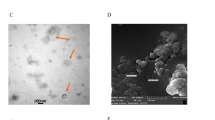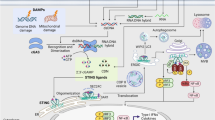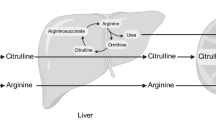Abstract
Hypoxia-inducible factor (HIF)-1 is a transcription factor known to play an important role in regulating the innate immune response to infection. Under baseline conditions, cellular HIF-1 levels in leukocytes are scarce, but levels rise rapidly in response to hypoxia or molecular signals of infection or inflammation such as microbial surface molecules and host-derived cytokines. Innate immune cells such as macrophages, neutrophils, and mast cells exhibit increased microbicidal activity when HIF-1 levels are increased, and mice lacking HIF-1 are more susceptible to invasive bacterial infection. In this study, we used genetic and pharmacologic means to determine whether HIF-1 also plays an important role in the adaptive immune response to infection. HIF-1α/Tie-2 Cre+ mice harboring a >90 % knockdown of HIF-1 in myeloid cells were studied. We found antigen-presenting cells from these mice that expressed lower levels of MHC-II and the costimulatory molecules CD80 and CD86, and were less able to induce T cell proliferation. These differences were present at baseline and persisted after activation. Increasing HIF-1 levels in wild-type (WT) cells by using the prolyl hydroxylase inhibitor drug AKB-4924 had the opposite effect, increasing MHC and costimulatory molecule expression and T cell proliferation. In experimental vaccination, HIF-1α/Tie-2 Cre+ mice exhibited a weaker T cell response and lower antibody levels in response to vaccination than WT mice, while WT mice treated with a drug to elevate HIF-1 responded more strongly to vaccination. Thus, HIF-1 participates in bridging the innate and adaptive immune responses and may merit further exploration as an adjuvant target.




Similar content being viewed by others
References
Zarember KA, Malech HL (2005) HIF-1α: a master regulator of innate host defenses? J Clin Invest 115:1702–1704
Cramer T, Yamanishi Y, Clausen BE, Forster I, Pawlinski R, Mackman N, Haase VH, Jaenisch R, Corr M, Nizet V et al (2003) HIF-1α is essential for myeloid cell-mediated inflammation. Cell 112:645–657
Wang GL, Jiang BH, Rue EA, Semenza GL (1995) Hypoxia-inducible factor 1 is a basic-helix-loop-helix-PAS heterodimer regulated by cellular O2 tension. Proc Natl Acad Sci USA 92:5510–5514
Semenza GL, Wang GL (1992) A nuclear factor induced by hypoxia via de novo protein synthesis binds to the human erythropoietin gene enhancer at a site required for transcriptional activation. Mol Cell Biol 12:5447–5454
Gu YZ, Moran SM, Hogenesch JB, Wartman L, Bradfield CA (1998) Molecular characterization and chromosomal localization of a third alpha-class hypoxia inducible factor subunit, HIF3α. Gene Expr 7:205–213
Hara S, Hamada J, Kobayashi C, Kondo Y, Imura N (2001) Expression and characterization of hypoxia-inducible factor (HIF)-3alpha in human kidney: suppression of HIF-mediated gene expression by HIF-3alpha. Biochem Biophys Res Commun 287:808–813
Ema M, Taya S, Yokotani N, Sogawa K, Matsuda Y, Fujii-Kuriyama Y (1997) A novel bHLH-PAS factor with close sequence similarity to hypoxia-inducible factor 1α regulates the VEGF expression and is potentially involved in lung and vascular development. Proc Natl Acad Sci U S A 94:4273–4278
Weidemann A, Johnson RS (2008) Biology of HIF-1α. Cell Death Differ 15:621–627
Wenger RH, Stiehl DP, Camenisch G (2005) Integration of oxygen signaling at the consensus HRE. Sci STKE 2005:re12
Silver IA (1977) Tissue PO2 changes in acute inflammation. Adv Exp Med Biol 94:769–774
Peyssonnaux C, Datta V, Cramer T, Doedens A, Theodorakis EA, Gallo RL, Hurtado-Ziola N, Nizet V, Johnson RS (2005) HIF-1α expression regulates the bactericidal capacity of phagocytes. J Clin Invest 115:1806–1815
Mecklenburgh KI, Walmsley SR, Cowburn AS, Wiesener M, Reed BJ, Upton PD, Deighton J, Greening AP, Chilvers ER (2002) Involvement of a ferroprotein sensor in hypoxia-mediated inhibition of neutrophil apoptosis. Blood 100:3008–3016
Oda T, Hirota K, Nishi K, Takabuchi S, Oda S, Yamada H, Arai T, Fukuda K, Kita T, Adachi T et al (2006) Activation of hypoxia-inducible factor 1 during macrophage differentiation. Am J Physiol Cell Physiol 291:C104–C113
Anand RJ, Gribar SC, Li J, Kohler JW, Branca MF, Dubowski T, Sodhi CP, Hackam DJ (2007) Hypoxia causes an increase in phagocytosis by macrophages in a HIF-1α-dependent manner. J Leukoc Biol 82:1257–1265
Sica A, Melillo G, Varesio L (2011) Hypoxia: a double-edged sword of immunity. J Mol Med (Berl) 89:657–665
Mancino A, Schioppa T, Larghi P, Pasqualini F, Nebuloni M, Chen IH, Sozzani S, Austyn JM, Mantovani A, Sica A (2008) Divergent effects of hypoxia on dendritic cell functions. Blood 112:3723–3734
Elia AR, Cappello P, Puppo M, Fraone T, Vanni C, Eva A, Musso T, Novelli F, Varesio L, Giovarelli M (2008) Human dendritic cells differentiated in hypoxia down-modulate antigen uptake and change their chemokine expression profile. J Leukoc Biol 84:1472–1482
Ricciardi A, Elia AR, Cappello P, Puppo M, Vanni C, Fardin P, Eva A, Munroe D, Wu X, Giovarelli M et al (2008) Transcriptome of hypoxic immature dendritic cells: modulation of chemokine/receptor expression. Mol Cancer Res 6:175–185
Jantsch J, Chakravortty D, Turza N, Prechtel AT, Buchholz B, Gerlach RG, Volke M, Glasner J, Warnecke C, Wiesener MS et al (2008) Hypoxia and hypoxia-inducible factor-1α modulate lipopolysaccharide-induced dendritic cell activation and function. J Immunol 180:4697–4705
Hellwig-Burgel T, Rutkowski K, Metzen E, Fandrey J, Jelkmann W (1999) Interleukin-1β and tumor necrosis factor-alpha stimulate DNA binding of hypoxia-inducible factor-1. Blood 94:1561–1567
Jung YJ, Isaacs JS, Lee S, Trepel J, Neckers L (2003) IL-1beta-mediated up-regulation of HIF-1α via an NFkappaB/COX-2 pathway identifies HIF-1 as a critical link between inflammation and oncogenesis. FASEB J 17:2115–2117
Wakisaka N, Kondo S, Yoshizaki T, Murono S, Furukawa M, Pagano JS (2004) Epstein-Barr virus latent membrane protein 1 induces synthesis of hypoxia-inducible factor 1α. Mol Cell Biol 24:5223–5234
Sodhi A, Montaner S, Patel V, Zohar M, Bais C, Mesri EA, Gutkind JS (2000) The Kaposi's sarcoma-associated herpes virus G protein-coupled receptor up-regulates vascular endothelial growth factor expression and secretion through mitogen-activated protein kinase and p38 pathways acting on hypoxia-inducible factor 1α. Cancer Res 60:4873–4880
Jantsch J, Wiese M, Schodel J, Castiglione K, Glasner J, Kolbe S, Mole D, Schleicher U, Eckardt KU, Hensel M et al (2011) Toll-like receptor activation and hypoxia use distinct signaling pathways to stabilize hypoxia-inducible factor 1 α (HIF1α) and result in differential HIF1α-dependent gene expression. J Leukoc Biol 90:551–562
Tang N, Wang L, Esko J, Giordano FJ, Huang Y, Gerber HP, Ferrara N, Johnson RS (2004) Loss of HIF-1α in endothelial cells disrupts a hypoxia-driven VEGF autocrine loop necessary for tumorigenesis. Cancer Cell 6:485–495
Blanco P, Palucka AK, Pascual V, Banchereau J (2008) Dendritic cells and cytokines in human inflammatory and autoimmune diseases. Cytokine Growth Factor Rev 19:41–52
Moore KW, de Waal MR, Coffman RL, O'Garra A (2001) Interleukin-10 and the interleukin-10 receptor. Annu Rev Immunol 19:683–765
Okumura CY, Hollands A, Tran DN, Olson J, Dahesh S, von Kockritz-Blickwede M, Thienphrapa W, Corle C, Jeung SN, Kotsakis A et al (2012) A new pharmacological agent (AKB-4924) stabilizes hypoxia inducible factor-1 (HIF-1) and increases skin innate defenses against bacterial infection. J Mol Med (Berl) 90:1079–1089
Ivan M, Kondo K, Yang H, Kim W, Valiando J, Ohh M, Salic A, Asara JM, Lane WS, Kaelin WG Jr (2001) HIFα targeted for VHL-mediated destruction by proline hydroxylation: implications for O2 sensing. Science 292:464–468
Spirig R, Djafarzadeh S, Regueira T, Shaw SG, von Garnier C, Takala J, Jakob SM, Rieben R, Lepper PM (2010) Effects of TLR agonists on the hypoxia-regulated transcription factor HIF-1α and dendritic cell maturation under normoxic conditions. PLoS One 5:e0010983
Acosta-Iborra B, Elorza A, Olazabal IM, Martin-Cofreces NB, Martin-Puig S, Miro M, Calzada MJ, Aragones J, Sanchez-Madrid F, Landazuri MO (2009) Macrophage oxygen sensing modulates antigen presentation and phagocytic functions involving IFN-gamma production through the HIF-1α transcription factor. J Immunol 182:3155–3164
Wang Q, Liu C, Zhu F, Liu F, Zhang P, Guo C, Wang X, Li H, Ma C, Sun W et al (2010) Reoxygenation of hypoxia-differentiated dendritic cells induces Th1 and Th17 cell differentiation. Mol Immunol 47:922–931
Yang M, Ma C, Liu S, Sun J, Shao Q, Gao W, Zhang Y, Li Z, Xie Q, Dong Z et al (2009) Hypoxia skews dendritic cells to a T helper type 2-stimulating phenotype and promotes tumour cell migration by dendritic cell-derived osteopontin. Immunology 128:e237–e249
Bernhardt WM, Wiesener MS, Scigalla P, Chou J, Schmieder RE, Gunzler V, Eckardt KU (2010) Inhibition of prolyl hydroxylases increases erythropoietin production in ESRD. J Am Soc Nephrol 21:2151–2156
Acknowledgments
We would like to thank Stephen Hedrick for providing us with the OT-I and OT-II mice, Robert Shalwitz and Anna Kotsakis of Aerpio Therapeutics for providing AKB-4924, and Davorka Messmer and Rebecca Saenz for their invaluable advice on experimental design. Research was provided by NIH/NIAID grants 093451 and 090863 to VN. TB was supported through the UCSD NIH/NIGMS Training Program in Molecular and Cellular Pharmacology (T32 007752) and the UCSD NIH/NIAMS Dermatology Investigator Training Program (T32 062496).
Conflict of interest
Randall Johnson, who provided the KO mice, is on SAB of Aerpio Therapeutics, who provided AKB-4924 HIF agonist. Victor Nizet and Aerpio Therapeutics have collaborated on NIH and Department of Defense grants. Aerpio Therapeutics had no interest in the design or reporting of the present study.
Author information
Authors and Affiliations
Corresponding author
Rights and permissions
About this article
Cite this article
Bhandari, T., Olson, J., Johnson, R.S. et al. HIF-1α influences myeloid cell antigen presentation and response to subcutaneous OVA vaccination. J Mol Med 91, 1199–1205 (2013). https://doi.org/10.1007/s00109-013-1052-y
Received:
Revised:
Accepted:
Published:
Issue Date:
DOI: https://doi.org/10.1007/s00109-013-1052-y




